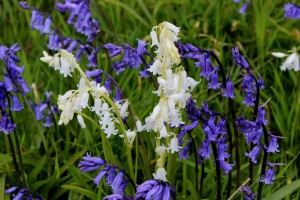 Many of us tend to just accept bluebells when we see them on the roadside verges or carpeting a woodland floor. Amongst other attributes it posed a problem for the organisation Plantlife as, in 2002, they launched a nationwide campaign for people to choose their County Flower. So many counties throughout the UK voted for the bluebell they had to take it off their lists and instead gave it the prestige title of the emblem for the whole of the UK. Interestingly these country flowers included Scots primrose for Caithness, bearberry for Aberdeenshire, spring cinquefoil for Cromarty and twinflower for Inverness-shire. So it appears that the bluebell has always been a very popular flower and who has not kept their eyes open for a white specimen shown here in the photograph I took at North Kessock? However, the common bluebell is in trouble by yet another alien that is now spreading, even into the Highlands in a number of places. It is the infamous Spanish bluebell that is sold in many garden centres. To tell the difference our native bluebell has a rather dangling stem whereas the Spanish bluebell has a more erect stem and is a paler hue. The problem is that the Spanish bluebell has inevitably spread into the wild and now freely interbreeds with the native bluebell.
Many of us tend to just accept bluebells when we see them on the roadside verges or carpeting a woodland floor. Amongst other attributes it posed a problem for the organisation Plantlife as, in 2002, they launched a nationwide campaign for people to choose their County Flower. So many counties throughout the UK voted for the bluebell they had to take it off their lists and instead gave it the prestige title of the emblem for the whole of the UK. Interestingly these country flowers included Scots primrose for Caithness, bearberry for Aberdeenshire, spring cinquefoil for Cromarty and twinflower for Inverness-shire. So it appears that the bluebell has always been a very popular flower and who has not kept their eyes open for a white specimen shown here in the photograph I took at North Kessock? However, the common bluebell is in trouble by yet another alien that is now spreading, even into the Highlands in a number of places. It is the infamous Spanish bluebell that is sold in many garden centres. To tell the difference our native bluebell has a rather dangling stem whereas the Spanish bluebell has a more erect stem and is a paler hue. The problem is that the Spanish bluebell has inevitably spread into the wild and now freely interbreeds with the native bluebell.
As regards what is happening in the Highlands I can only go by the latest distribution maps I have which is in the much acclaimed “New Atlas of the British & Irish Flora” published in 2002. There is an amusing story behind this massive volume as it was very late being published after its supposed date. I heard a rumour that it was on the proverbial “slow boat to China”. I looked on this as a joke but later found it had indeed been printed in China so it would indeed have been on a slow boat getting here! This flora indicates the Spanish bluebell is indeed in the Highlands and spreading and it is hybridising with the native bluebell. I wonder how many readers have unconsciously assisted this problem, by buying the Spanish bluebells? Ironically you can now see adverts saying “native bluebells for sale” which just shows how people capitalise on the problem.
There are very few wildflowers that have such a chequered history as the bluebell either in myths, folk-lore or even magic. One intriguing aspect is that bluebells are said to indicate ancient woodland. So if you are wandering through woodland whose floor is bedecked with masses of delicate scented bluebells, the woodland may well be hundreds of years old. What impresses many people, including myself, is that they are the harbingers of spring as much as the primroses, snowdrops and cuckoo flowers and a welcome sight after the long winter months. Bluebells seem to have it all as it was dominant in medicine and yet had the reputation of being poisonous. They were known for curing leprosy and tuberculosis and even a cure for snake bite. Even today the alkaloids in bluebells may be used to develop a medicine in the fight against cancer and HIV. However, there have been many other uses and one intriguing one was the glue obtained from bluebell sap. This was used as a glue to attach “feather flights” onto arrows and later for book binding.
To many people the consequence of the hybridisation between the native bluebell and the Spanish bluebell may seem of little consequence. What puts it into perspective is the amazing fact that we often overlook. Almost a third of the native bluebells in the entire world grow in the British Isles which is an important fact to bear in mind.
Tags: highland flora
